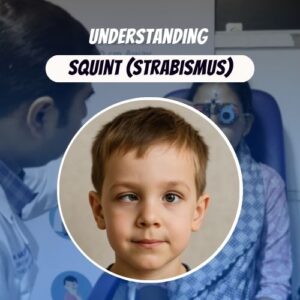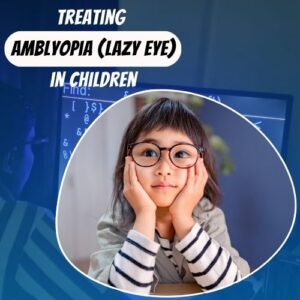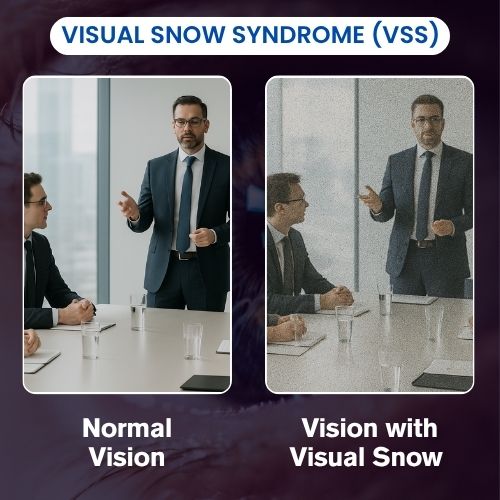Visual Snow Syndrome: Causes, Symptoms, and Treatments
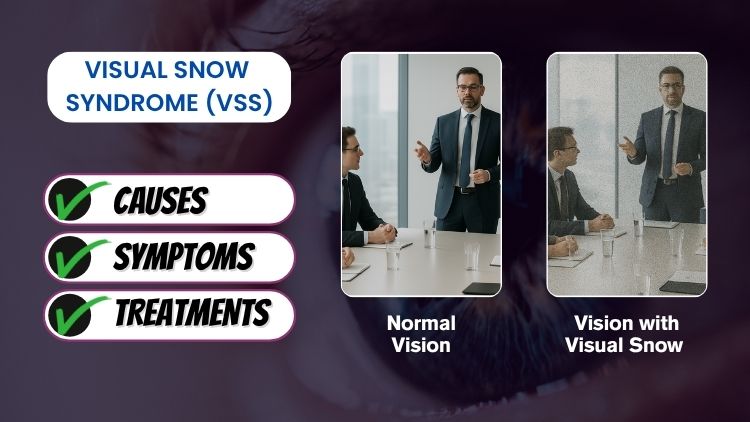
Visual Snow Syndrome (VSS) is a rare and often misunderstood neurological visual disturbance that causes individuals to see tiny, flickering dots—commonly referred to as “visual snow”—across their entire field of vision. Unlike typical eye conditions, this visual static is persistent and unaffected by lighting conditions or eye movement, often appearing even when the eyes are closed. Visual Snow Syndrome can significantly impact quality of life, leading to challenges with reading, driving, screen usage, and even sleep.
In many cases, it’s accompanied by other symptoms such as photophobia (light sensitivity), afterimages (palinopsia), tinnitus, dizziness, and cognitive disturbances like brain fog. While VSS shares visual similarities with migraines, floaters, and eye strain, it is a unique neurological disorder that is not yet fully understood. As awareness grows, more people are seeking accurate diagnoses, symptom relief, and long-term treatment options for this complex condition. This blog will explore the causes, symptoms, diagnosis, and treatment options for Visual Snow Syndrome, offering helpful information for those affected and their caregivers.
What is Visual Snow Syndrome?
Visual Snow Syndrome is primarily characterized by seeing tiny, flickering dots in your vision, similar to TV static. This “visual snow” is always present, whether your eyes are open or shut, and remains unchanged regardless of the lighting conditions.
How VSS Differs from Other Visual Disturbances
- Floaters: Those drifting shapes in your vision are caused by changes in the eye’s internal gel due to ageing, resulting in moving floaters.
- Migraine aura: Before a migraine, there may be unusual visual disturbances, such as blind spots or zigzag patterns.
- Normal eye strain or light sensitivity: Visual snow syndrome can be temporary, caused by external factors such as prolonged screen time or exposure to bright lights, and may resolve once the cause is removed.
- Visual Snow: continuous visual disruption across the entire field of vision, unaffected by lighting or eye movement.
Prevalence and Research
Although Visual Snow Syndrome is relatively rare and frequently misdiagnosed, it typically begins in adolescence or early adulthood. Recent research is helping to uncover its neurological roots and guiding the development of potential treatments.
Symptoms of Visual Snow Syndrome
Core Visual Symptom
- Visual Snow: continuous, widespread flickering dots, which may be black, white, coloured, or transparent, affecting the entire visual field.
Additional Visual Symptoms
- Afterimages (Palinopsia): lasting afterimages even after the removal of the originating item.
- Photophobia: increased light sensitivity.
- Blue field entoptic phenomenon: When you stare at bright skies, you see white dots that move quickly.
- Nyctalopia: Trouble seeing clearly in low light or darkness.
- Other visual phenomena: flashes of light, halos surrounding lights, starbursts, double vision, or distorted vision.
Non-Visual Symptoms
- Tinnitus: Ringing or buzzing in the ears.
- Dizziness or Balance Issues: Vertigo or dizziness.
- Cognitive Effects: Brain fog, fatigue, difficulty concentrating, or memory lapses.
- Other symptoms include sleep issues, depersonalization (feeling separated from oneself), derealization (the belief that the world is fake), or tingling sensations.
Nandadeep Eye Hospital provides expert evaluations and advanced diagnostic care for complex visual disturbances, including Visual Snow Syndrome.
Causes and Risk Factors
The exact cause of VSS remains unclear, but several contributing factors are being studied:
- Neurological hyperexcitability: hyperactivity in the visual processing areas of the brain, particularly the occipital cortex.
- Migraine Connection: Most individuals with Visual Snow Syndrome (VSS) frequently experience migraines, indicating potential typical neural connections.
- Head Trauma: Visual snow syndrome symptoms may arise after head trauma or concussions.
- Drug Triggers: The intake of hallucinogens or specific drugs has been associated with the onset of symptoms.
- Genetic Factors: Family history could increase vulnerability, although solid findings are absent.
- Stress and Mental Health: Stress, anxiety, and lack of sleep may intensify symptoms; however, they are not the major causes.
Diagnosis
Visual Snow Syndrome diagnosis is difficult due to the lack of a specific test and relies on ruling out other conditions.
Steps in Diagnosis
- Medical History: Comprehensive details on the symptoms, duration of time, and lifestyle factors.
- Eye Examination: Medical testing is required to exclude retinal or optic nerve problems.
- Neurological Imaging: Brain abnormalities can be detected with the use of MRI or CT scans.
- Visual Function Testing: confirms ongoing visual disturbances.
- Diagnostic Criteria: Visual snow persisting for at least three months, accompanied by two or more additional visual symptoms like photophobia or palinopsia, and not explained by any other condition.
Treatment Options
1. Medicines
Visual Snow Syndrome features persistent visual disturbances, like snow, caused by increased brain activity. Treatment focuses on regulating this activity with medication to reduce’ the ‘snow’ effect, though it’s not a cure. Therapies for emotional issues can also help manage the condition.
2. Lifestyle Changes
- Avoid caffeine: Especially in the evening—it can affect sleep.
- Fix Your Sleep Routine: Go to bed and wake up at the same time every day.
- Better Sleep Setup: Keep your room dark, cool, and quiet.
- Limit Screen Time: Reduce phone or computer use before bed; use blue-light filters.
3. Therapies
- CBT (Cognitive Behavioural Therapy): Helps manage stress, anxiety, or low mood.
- Neuro-Optometric Rehab: Eye exercises to improve focus, awareness, and visual comfort.
- Tinted glasses: Special lenses can reduce light sensitivity and visual discomfort.
- rTMS (Brain Stimulation): A new method using gentle magnetic pulses to calm the brain.
- Visual Training: Simple vision therapy exercises to help adapt to symptoms.
Living with Visual Snow Syndrome
Getting used to life with VSS can be difficult, especially given the lack of understanding and support. Nonetheless, a lot of people continue to live happy lives.
- Daily Coping Strategies: Creating structure, using tinted glasses, managing stress, and limiting exposure to triggers.
- Support Networks: Online communities and advocacy groups offer valuable emotional and practical support.
- Professional Help: Regular check-ins with neurologists, neuro-ophthalmologists, and mental health professionals are essential.
- Awareness and Education: Educating others (including healthcare providers) can reduce stigma and promote early recognition.
Future Research and Hope
Increasing scientific and clinical interest in Visual Snow Syndrome is leading to research focused on its causes and treatment.
- Brain imaging to map the neurological patterns of VSS.
- Clinical trials of medications aimed at stabilising visual processing.
- Neuromodulation and brain stimulation techniques.
Progress in understanding and treating visual snow syndrome is being made due to increased awareness and patient advocacy.
Conclusion
Visual Snow Syndrome significantly affects both vision and overall quality of life, but individuals living with this condition are not alone. With the right diagnosis, personalised eye treatment plans, and effective symptom management strategies, many people can successfully adapt and continue to lead fulfilling lives. As ongoing research advances and public awareness grows, there is increasing hope for more targeted therapies and long-term solutions for those affected by neurological visual disturbances like Visual Snow Syndrome.
More Posts
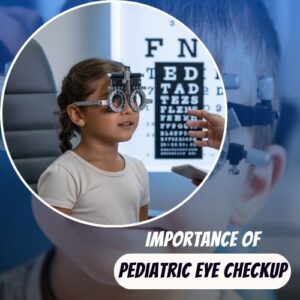
Everything You Should Know About Pediatric Eye Exams

काचबिंदू (Glaucoma): नियमित नेत्रतपासणी का आवश्यक आहे?
